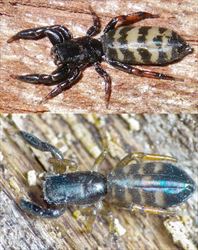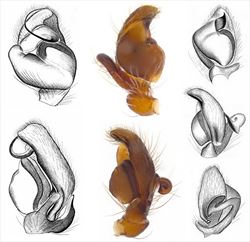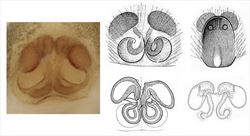
Examples of live Zebraplatys
Illustrators (and ©) R. Whyte (B) & A. Parsons (T)

Aspects of the general morphology of Zebraplatys
Illustrators (and ©) B.J. Richardson (CSIRO), M. Zabka (diag,) (WAMP)

Palp morphology of Zebraplatys
Illustrators (and ©) B.J. Richardson (CSIRO), M. Zabka (diag,) (WAMP)

Epigyne morphology of Zebraplatys
Illustrators (and ©) B.J. Richardson (CSIRO), M. Zabka (diag,) (WAMP)
Zebraplatys Zabka, 1992
Taxonomy
Zebraplatys has four Australian species: Zebraplatys fractivittata Z. harveyi, Z. keyserlingi and Z. quinquecingulata and, doubtfully, a species from Taiwan. The genus is part of an Australasian clade (Maddison et al 2008) including Abracadabrella, Apricia, Clynotis, Holoplatys, Huntiglennia, Ocrisiona, Opisthoncus, Paraplatoides, Pungalina, Tara and Trite (Maddison 2015). Further information on the genus and described species can be found in Richardson and Żabka (2017) and Whyte and Anderson (2017).
Description
Zebraplatys spp. are small to medium-sized spiders, ranging in body length from 3 to 8 mm. The head, viewed from above, is elongate-pear-shaped, widest behind the posterior lateral eyes with a narrow squared-off anterior edge. The carapace is very low and flat. Chelicerae have a single (unident) retromarginal tooth and two promarginal teeth. The abdomen is elliptical to ovate. The first pair of legs can be heavier than the others, sometimes substantially so. The fourth pair of legs is longest.
The male’s palp is quite variable in form between species. The embolus arises on the distal edge of the tegulum and may be short, curved and strongly built or long and thin. It may coil in either a clockwise or anticlockwise direction. The tegulum is variable in shape but always with a large proximal, lateral or ventral lobe. The palpal tibia has two apophyses. The more ventral one is small and rounded while the anterior one is sometimes wildly elongate and bizarrely shaped, varying in size from small to huge between species.
The female epigyne has two epigynal atria with the location of the copulatory openings changing between species. From these openings the insemination ducts follow a curved course, varying between species, but ultimately leading anteriorly to the pear-shaped spermathecae. These are anterior to (but sometimes overlapping) the anterior edge of the atria.
Biology
Zebraplatys is usually found under bark and in other crevices but has been collected from pitfall traps, in a wide variety of drier habitats.
Distribution
The genus has been found in all mainland States and Territories. It is most common in Western Australia.
References
Maddison, W.P. 2015. A phylogenetic classification of jumping spiders (Araneae: Salticidae). Journal of Arachnology 43, 231-292.
Maddison, W.P., Bodner, M.R. & Needham, K.M. 2008. Salticid spider phylogeny revisited, with the discovery of a large Australian clade (Araneae: Salticidae). Zootaxa 1893, 49-64.
Richardson, B.J. & Żabka, M. 2017. Salticidae. Arachnida: Araneomorphae. Canberra, Australian Faunal Directory. Australian Biological Resources Study, at https://biodiversity.org.au/afd/taxa/SALTICIDAE.
Whyte, R. & Anderson, G. 2017. A field guide to the spiders of Australia. Clayton: CSIRO Publishing 451pp.
Żabka, M. 1992. Salticidae (Arachnida: Araneae) of the Oriental, Australian and Pacific Regions, VIII. A new genus from Australia. Records of the Western Australian Museum 15, 673-684.
* The information sheet should be read in the context of the associated diagrams and photographs. Diagrams explaining anatomical terms can be found in the ‘Salticidae’ pictures at the beginning of the list of genera.